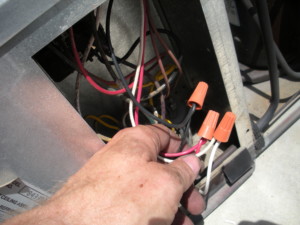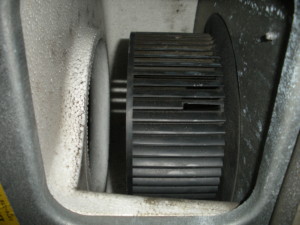Diagnosing a blower motor problem and sourcing the replacement motor have been discussed in part 1. If you need to replace your blower motor, and have the part on hand, here’s how to do it. Start to finish, depending on how many times you go up and down the ladder, should take less than an hour.
Tools needed:
- #2 Philips screwdriver
- #3 Philips screwdriver for outer cover (some models use Torx screws or hex nuts)
- Wire cutters and strippers
- 3 wire nuts
- 9mm wrench
- 5/32 Allen
- Foil tape
- Possibly a hammer and rust penetrant
- Permanent marker
- Camera (optional)
Before you go up on the roof, turn off power to the air conditioner at the circuit breaker. I strongly recommend verifying power is off with a non-contact voltage tester, like the one on the meter here. Switch to the “NCV” setting, and point the tip of the clamp at any wire to see if there’s an AC voltage present.
Getting Access
Start by taking off the outer plastic air conditioner cover. There will be 4 fasteners holding it on. In my case, they were large-head Philips screws, though on some models these will be Torx screws or on older models a hex nut. As long as you don’t expect any wind, just set it aside on the roof. If there’s a chance of wind, take it down the ladder–these covers can get brittle and it doesn’t take that strong of a gust to carry them overboard.
Remove the Philips screws holding the flat metal cover over the compressor. There are two types of screws–one with a pointed tip, and another with a blunt tip. Use a marker to make note of which type goes where. You’ll have to cut (or tear) the foil tape over the joint shown in the picture. Also remove the access panel in the lower left of the above picture so that you can get to the wiring connections for the blower motor.
Getting the Blower Motor Out
Remove the five screws holding the blower motor mounting plate to the evaporator housing. There are three across the top, and one in each lower corner. Also remove the two screws holding the motor support bracket to the bottom pan. At this point, the motor is physically loose, but not free. Go ahead and loosen the 5/32″ Allen screw that holds the condenser fan on the motor shaft. If it’s not too rusty, you may be able to slide the fan toward the motor, in which case you shouldn’t have to remove the fan shroud.
Assuming it doesn’t move easily, remove the screws holding the fan shroud in place. There are 5 screws at each end, including one that also holds one of the refrigerant lines going to the condenser.
Blower Motor Wiring
Follow the 5 wires coming from the blower motor through the wall into the wiring box (there’s probably a better name for it–I’m referring to the area behind the access panel you removed at the beginning).
Two of them (brown) will go to spade connectors on a capacitor–remove them, making note of which terminal has the wire with the white stripe. Pull them loose, then identify the other three wires (red, black, and white), and look for wire nuts or crimp terminals already on them. If they’re wire nuts, the blower has probably been replaced before, and you can just undo them. Otherwise, you’ll need to cut each of those wires to get the old motor disconnected.
Next, remove the blower, fan, and motor as an assembly. You’ll have to angle it out so that the blower motor clears the evaporator housing, but it’s pretty easy to figure out. Lift the fan shroud as needed to get enough clearance. Climb down off the roof with this assembly and head to a table with the new motor. Make sure to take the 5/32″ Allen wrench with you.
Transferring Blower Wheels
If you don’t have access to the blower from inside the RV, measure the distance between the blower wheel and the backing plate. Loosen the 5/32″ Allen screw holding the blower wheel on the motor shaft and remove the wheel from the motor. This should require very little effort. There’s a missing part of a blade on the blower wheel for inserting the Allen wrench as shown:
Remove the nut holding the motor support bracket on and transfer to the new motor. Don’t tighten yet–it’s easier to get it lined up right once the motor is back on the AC unit.
Next, we need to separate the blower motor from the metal panel you see above. There are four 9mm nuts holding it in place, under a foam panel. If you use a box end wrench, you can feel for them and just let the foam tear slightly as you loosen and remove them.
Transfer the plate to the new motor, and reinstall:
What you should have left is the old motor by itself, with the condenser fan still attached. Because it has spent time out in the weather, it may need some healthy encouragement to slide off–this is where the rust penetrant and hammer come in. Don’t be afraid of it, but be careful not to hit the fan itself–hold the fan (better yet, have a helper hold it for you), and strike the motor shaft.
Slide the fan onto the new motor’s shaft as far as it will go, but don’t tighten the screw. If you have access to the blower wheel from inside, do the same for it. If not, replace the blower wheel with your measured distance and tighten the screw.
Reassembly
Head back up to the roof with the 9mm wrench, 5/32″ Allen wrench, wire nuts, foil tape, and the rest of the tools you used (or left up there) when taking the motor out.
Re-mount the metal plate that goes on the evaporator housing first. Then feed the 5 wires through the grommet and reconnect them using 3 wire nuts and pushing the two brown wires back onto the capacitor as before.
Anchor the motor support bracket to the bottom pan with two screws, then tighten the nut on the back of the motor with the 9mm wrench. Slide the condenser fan back in to place and tighten the Allen screw. If you removed the fan shroud, replace the screws holding it on.
Optional: Before you close everything up, take a picture of the air conditioner’s name plate. This contains the model number and a number of other specifications that could come in handy in the future.
Replace the wiring access panel, and the top cover over the compressor and blower motor. Use a piece of foil tape over the seam at the evaporator housing. Replace the outer cover and its 4 screws. Come down off the roof, bringing all of the tools.
If you have access to the blower wheel from inside, and haven’t tightened its screw, now is the time to do that. For best performance, you want the open end of the wheel (furthest from the motor) as close to the evaporator as possible.
The picture above shows about where the wheel probably sits if you shoved it most of the way on the shaft. Below is how you want it to end up, in order to get the most airflow. Just make sure it’s not touching the styrofoam to its left. Snug the 5/32″ Allen screw to hold it in place.
Replace the inside ceiling assembly, restore power, and test it out. That’s it!












Thanks for the instructions. I should have read this before I removed the wheel from the shaft. I had to go buy a longer 5/32 allen wrench 🙁
I have this same unit. My capacitors need to be replaced but the numbers are worn off both of them. Can anyone help???
I had a 7.5microfarad dual 370/440V capacitor on mine.